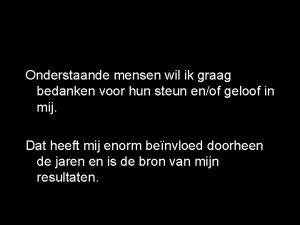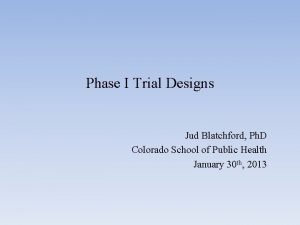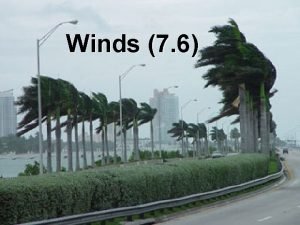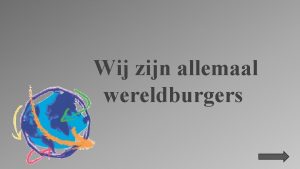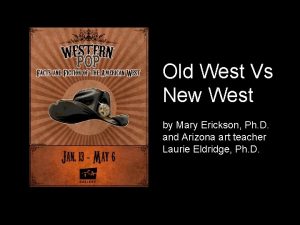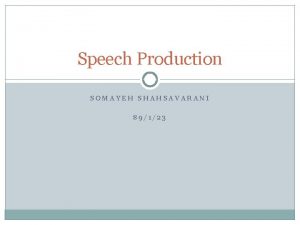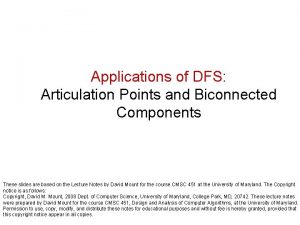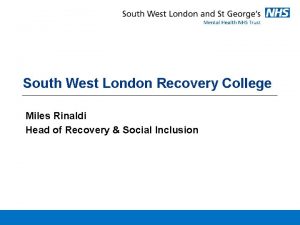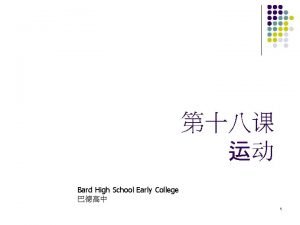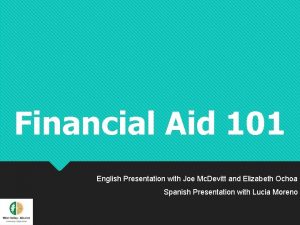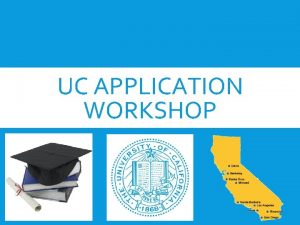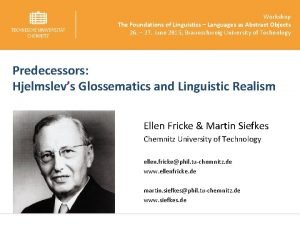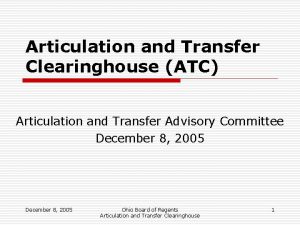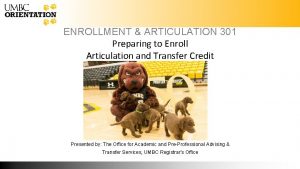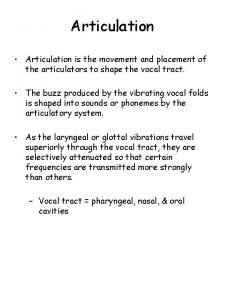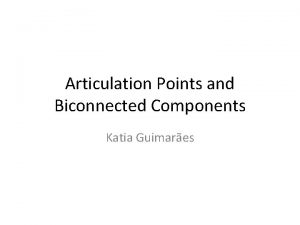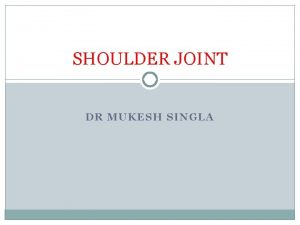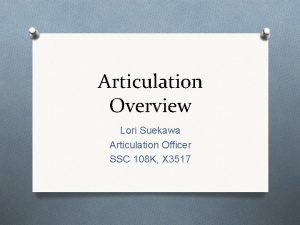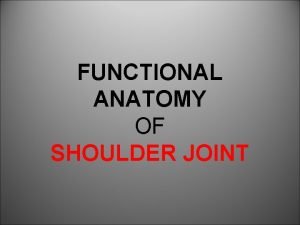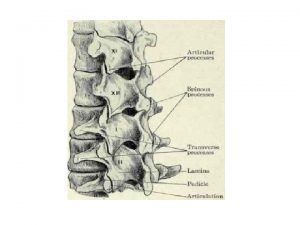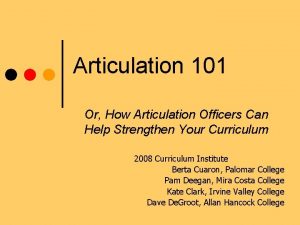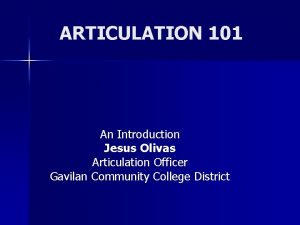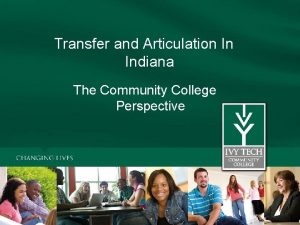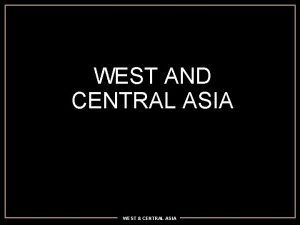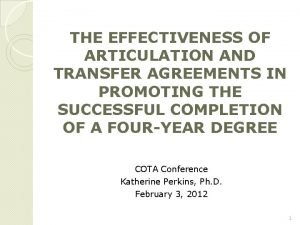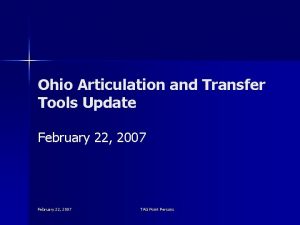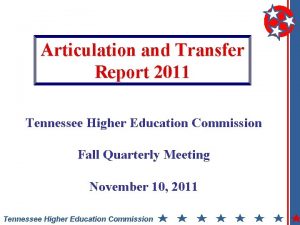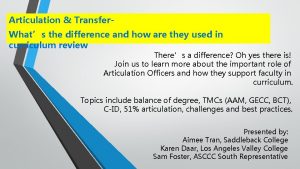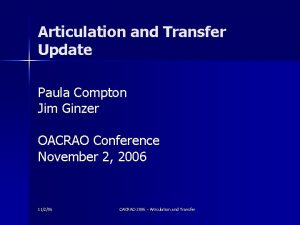Articulation and Transfer STEPHANIE DUMONT GOLDEN WEST COLLEGE



























- Slides: 27

Articulation and Transfer STEPHANIE DUMONT GOLDEN WEST COLLEGE MICHELLE PILATI RIO HONDO COLLEGE

Overview • • Introductions Transfer/Articulation and You C-ID (www. c-id. not) Lower Division Transfer Patterns (LDTP) UC Statewide Transfer Preparation Pathways Statewide Career Pathways ASSIST (www. assist. org)

Transfer and You • What mechanism(s) do you have for determining that a course should be transferable? • What criteria or evidence are used to make this determination?

Articulation and You • Who is your go-to person for articulation? • What do they do? • How much do you know about what this person does?

Transfer and CSU • CSU Executive Order No. 167 Transfer of Credit • Courses which have been developed and are recommended by the faculty of a regionally accredited college or university and designated as appropriate for baccalaureate credit by that institution shall be accepted by any campus of The California State University and Colleges for credit toward its baccalaureate degrees.

Transfer and UC • Courses must be submitted for consideration • Transfer status typically granted if course is comparable to a lower division course at any UC

Course Identification Number System (C-ID) A proposal to replace and expand CAN Øa supra-numbering system Øa response to mandates & needs Øa published set of course descriptors for use by postsecondary institutions and CCC students and faculty

What is C-ID? • Intersegmental • Faculty-driven • Voluntary

Why C-ID? Why CAN? • A uniform course-numbering system like that in place in FL is unnecessary in CA, excessively costly and bureaucratic, and probably unworkable because of the size and complexity of CA higher education. .

Why C-ID? Why CAN? • Such a uniform system appears to make unduly simplistic assumptions about the comparability or equivalency of courses offered by different institutions and gives CC students and counselors a false sense of security about equivalency if they are not familiar with the special conditions and limitations imposed by some institutions on transfer courses with common numbers • http: //www. cansystem. org/CAN_Guide. pdf

In other words. . • CAN offered a means of identifying comparable courses while respecting existing numbering systems and local control of curriculum. • C-ID will do the same – and address some of the criticisms of CAN.

What happened to CAN? • CAN (California Articulation Numbering System (1985 -2005) • Advantages: Articulation, Shared number, Widely used • Disadvantages: Lacked UC participation, Not sufficiently descriptive, Outdated, Limited faculty review • CAN becomes a CCC Orphan: January 2005

CI-D Project Overview • 09 -10 Year 3 • Reviewing draft descriptors – and developing more • Finalizing “validation” process – and determining how to “implement”

FDRGs • Faculty Discipline Review Groups • Intersegmental faculty develop descriptors • Descriptors are posted for statewide review at www. c-id. net

Senate Bill 1785 (2004) • CSU • LDTP • Calls on CSU to develop “a systemwide lower division transfer curriculum” • . . existing procedures such as CAN program shall be employed.

LDTP • Lower Division Transfer Pattern • An answer to legislation • Called for – Identifying commonalities – Hinted at a “numbering system” – “Highest priority” for admission

LDTP • “Common” courses identified • TCSU process created – Descriptor that would be acceptable to majority of CSUs – Course with TCSU designation must be accepted by all CSU – Issues with “validation” process

LDTP • • Lack of CCC involvement Timelines not reasonable Poor communication Fear of loss of local articulation

LDTP and Curriculum • What impact has LDTP had on your curriculum? • Should it have an impact?

UC Statewide Transfer Preparation Pathways • Common major prep for top 21 UC majors: http: //uctransfer. universityofcalifornia. edu/stat ewide_paths. html • Lists campuses that offer the same or similar major as well as related majors and specializations

UC Statewide Transfer Preparation Pathways • Has common core and campus-specific requirements • Includes selection requirements for competitive admission • Recommends major-specific GE preparation • Works in conjunction with ASSIST

Statewide Career Pathways

Statewide Career Pathways Project Goal • Facilitate articulation between high schools, ROCPs, and colleges. • Also – – Increase awareness of CTE • Internal • External – Remove barriers

Facilitating Articulation • • Create templates Database – – • Templates Articulation Outreach

Identified “Barriers” § Transcript issues § Delayed credit; “credit in escrow” § University articulation issues § Will UC/CSU accept credit granted for HS work? § Database resistance § Is a commitment implied if I post an articulation agreement?

ASSIST • What is ASSIST? • Why/how might it be used by curriculum committees and those developing curriculum?

Conclusions • Take home messages • Questions
 Minka dumont lesmateriaal
Minka dumont lesmateriaal Teori kapilaritas sosial diplopori oleh
Teori kapilaritas sosial diplopori oleh Exemple pratique de la norme iso 17025
Exemple pratique de la norme iso 17025 Santos dumont de andrade
Santos dumont de andrade Kris dumont
Kris dumont Teori kependudukan arsene dumont
Teori kependudukan arsene dumont Golden ratio and golden rectangle
Golden ratio and golden rectangle The last supper golden ratio
The last supper golden ratio East is east and west is west
East is east and west is west Winds that blow over short distances are called
Winds that blow over short distances are called What creates wind
What creates wind Zuid noord west oost
Zuid noord west oost Old west vs new west
Old west vs new west Difference between phonation and articulation
Difference between phonation and articulation Balanced articulation
Balanced articulation Phonation and articulation
Phonation and articulation Phonation and articulation
Phonation and articulation Biconnected components and articulation points
Biconnected components and articulation points Is a disturbance that transfers energy
Is a disturbance that transfers energy West african college of nursing lagos
West african college of nursing lagos West london recovery college
West london recovery college Cccco guided pathways
Cccco guided pathways Bard high school early college west
Bard high school early college west West thames moodle
West thames moodle Joe mcdevitt west valley college
Joe mcdevitt west valley college Connecticut college transfer
Connecticut college transfer Irvine valley college transcripts
Irvine valley college transcripts Double articulation
Double articulation




